September 13th Scots Book of Days
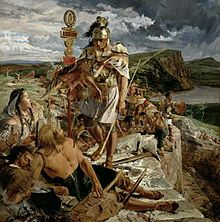 September 13 – 122 Construction of Hadrian’s Wall begins. Hadrian’s Wall was declared a World Heritage Site in 1987, and in 2005 it became part of the transnational “Frontiers of the Roman Empire”.
September 13 – 122 Construction of Hadrian’s Wall begins. Hadrian’s Wall was declared a World Heritage Site in 1987, and in 2005 it became part of the transnational “Frontiers of the Roman Empire”.
Publius Aelius Traianus Hadrianus (Emperor Hadrian)
William Bell Scott 1857. English: The Romans Cause a Wall to be Built for the Protection of the South The Painting shows a centurion supervising the building of Hadrian’s Wall. The centurion has been given the face of John Clayton, who was responsible for saving parts of the Wall from loss. The painting is in the collection at Wallington Hall, near Morpeth, England.
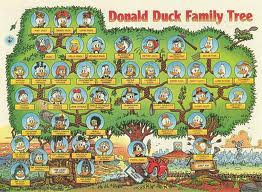 Fictional clan McDuck is known since 122 AD, when an, as of yet, unnamed member of the clan sold stone to the construction crew of Hadrian’s wall. The Clan McDuck was originally called the Clan MacDuich, but dropped the Gaelic spelling of the name in 1071 and became the McDucks. The most famous members of the clan are Scrooge McDuck and Donald Duck.
Fictional clan McDuck is known since 122 AD, when an, as of yet, unnamed member of the clan sold stone to the construction crew of Hadrian’s wall. The Clan McDuck was originally called the Clan MacDuich, but dropped the Gaelic spelling of the name in 1071 and became the McDucks. The most famous members of the clan are Scrooge McDuck and Donald Duck.
McDuck family tree.
335 Holy Cross Day feast day. The date of the feast marks the dedication of the Church of the Holy Sepulchre in 335. This was a two-day festival: although the actual consecration of the church was on September 13,
407 John Chrysostom, Bishop of Constantinople, Teacher of the Faith, feast day.
934 – Constantine II witnessed a charter with Æthelstan at Buckingham on 13 September 934 in which he is described as subregulus, that is a king acknowledging Æthelstan’s overlordship.
Athelstan `the Glorious’ (King) of ENGLAND, possibly aka Athelstan of the SAXONS; possibly an inspiration for some of Monmouth’s stories of CAMELOT Born: abt. 895 Died: abt. 939, HM George I’s 21-Great Half-Uncle. U.S. President Benjamin Harrison’s 24-Great Half-Uncle.
1217 Treaty of Lambeth – Louis needed Papal ratification and sought it from the Papal legate, who was encamped near Kingston, on the 13th September.
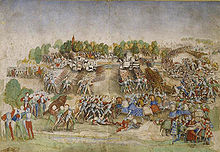 1515 Battle of Marignano. the Italian Wars (1494–1559) called the War of the League of Cambrai, between France and the Old Swiss Confederacy. It took place on September 13 and 15, 1515, near the town today called Melegnano, 16 km southeast of Milan. It resulted in a victory for French forces.
1515 Battle of Marignano. the Italian Wars (1494–1559) called the War of the League of Cambrai, between France and the Old Swiss Confederacy. It took place on September 13 and 15, 1515, near the town today called Melegnano, 16 km southeast of Milan. It resulted in a victory for French forces.
In 1515, the Franco-Venetian alliance decisively defeated the Holy League at the Battle of Marignano.
1541 – After three years of exile, John Calvin returns to Geneva to reform the church under a body of doctrine known as Calvinism. Calvinism became the theological system of the majority in Scotland (see John Knox), the Netherlands, with men such as William Ames, T J Frelinghuysen and Wilhelmus à Brakel and parts of Germany (especially next to the Netherlands) with Olevianus and his colleague Zacharias Ursinus. Calvinism was influential in France, Hungary, Transylvania, Lithuania and Poland. Scandinavia, especially Sweden, but was rejected in favor of Lutheranism after the synod of Uppsala in 1593. Most settlers in the American Mid-Atlantic and New England were Calvinists, including the English Puritans, the French Huguenot and Dutch settlers of New Amsterdam (New York after 1664), and the Scotch-Irish Presbyterians of the Appalachian back country.
1556 John Knox arrived in Geneva, for 2 year visit.
1644 Second Battle of Aberdeen
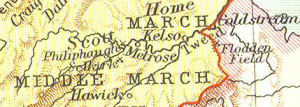 1645 Battle of Philiphaugh an elevated ascent, called Philiphaugh, on the [TG43-21] left bank of the Ettrick. So incamped Montrose, who had no information of the vicinity of Lesley, and the Covenanters, who surprised the Royal forces. James Ogilvy 2nd Earl of Airlie was captured. The Earl was imprisoned in St Andrews Castle but escaped one night before the day of his execution, disguised in his sister’s clothes. The ‘Bonnie Hoose o’ Airlie’ was destroyed in the Civil War by the Clan Campbell and this tragic incident is described in a ballad from the time.
1645 Battle of Philiphaugh an elevated ascent, called Philiphaugh, on the [TG43-21] left bank of the Ettrick. So incamped Montrose, who had no information of the vicinity of Lesley, and the Covenanters, who surprised the Royal forces. James Ogilvy 2nd Earl of Airlie was captured. The Earl was imprisoned in St Andrews Castle but escaped one night before the day of his execution, disguised in his sister’s clothes. The ‘Bonnie Hoose o’ Airlie’ was destroyed in the Civil War by the Clan Campbell and this tragic incident is described in a ballad from the time.
- Campbell Earl of Argyll 1010 2Montgomery2Blair 2Cochrane2Miller 2Simmons2Choate to zoe TOAG
William 11th earl of Angus, 1st Marquis of Douglas escaped from the rout. Anderson Scot’s History v. 2/p. 48
- Douglas 1036 2Stewart 2Ruthven 2Kinchin 2Jared 2Simmons 2Choate – Douglas 2Montgomberie 2Blair 2Cochrane 2Miller 2Simmons 2Choate – Douglas 2Hamilton 2Stewart 2Miller 2Simmons 2Choate – Douglas 2Carlyle 2Semple 2Montgomery 2Cochrane 2Miller 2Simmons 20Choate
William (1st Marquess & 11th Earl of Angus) DOUGLAS Born: abt. 1589 Died: 1660, PM Churchill’s 8-Great Grandfather. Lady Diana’s 10-Great Grandfather. PM Cameron’s 11-Great Grandfather. HRH Albert II’s 9-Great Grandfather
Battle of Philiphaugh is marked (middle of map) by the small crossed swords on the Ettrick above the confluence with the River Tweed in the Middle March.
1739 – In 1758, Robert Miller (III) [clans Hunter, Meldrum, Cochrane, Stewart, Lockhart] married Jane (Jean) Pickens, sister of Andrew Pickens, (born September 13, 1739 – August 11, 1817). Andrew as a colonel and then a general, with Marion and Sumter, held western South Carolina against the British in the War of Independence. Jean’s nephew Andrew Pickens II was governor of the state of South Carolina during the latter part of the War of 1812; YYMA 94. Andrew’s 6th great grandson Senator John Edwards was Democratic nominee for Vice President in 2006.
1743 – Great Britain, Austria and Savoy-Sardinia sign the Treaty of Worms.
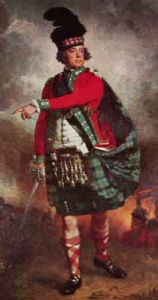 1752 DID NOT occur in England or British America. The English civil year started on 25 March until 1752 (Scotland having changed to 1 January in 1600). Eleven days did not occur in September 1752 in both England and Scotland, as well as other British controlled territories – America, (when the day after 2 September was 14 September so as to bring the British Empire fully in line with the Gregorian calendar.
1752 DID NOT occur in England or British America. The English civil year started on 25 March until 1752 (Scotland having changed to 1 January in 1600). Eleven days did not occur in September 1752 in both England and Scotland, as well as other British controlled territories – America, (when the day after 2 September was 14 September so as to bring the British Empire fully in line with the Gregorian calendar.
1759 Battle of Quebec. The French and Indian War also known as the Seven Year War (1757 – 1762). Fraser’s Highlanders, disbanded at the end of the war.
Highland Officer. A French sentry challenged the boats but was answered by a highland officer in French.
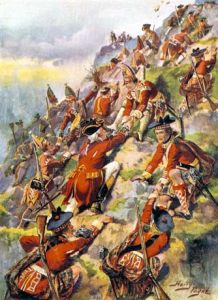 General Wolfe’s army scales the Heights of Abraham in the attack on Quebec. Casualties Fraser’s Highlanders: 187.
General Wolfe’s army scales the Heights of Abraham in the attack on Quebec. Casualties Fraser’s Highlanders: 187.
1766 – Samuel Wilson, possible namesake of Uncle Sam (d. July 31, 1854) parents originally from Greenock, Scotland. At the time of the War of 1812, Samuel Wilson was a prosperous middle-aged meat-packer in Troy. He obtained a contract to supply beef to the Army in its campaign further north, which he shipped in barrels. The barrels, being government property, were branded with the initials “U.S.”, but the teamsters and soldiers would joke that the initials referred to “Uncle Sam”. The 87th United States Congress adopted the following resolution on September 15, 1961: “Resolved by the Senate and the House of Representatives that the Congress salutes Uncle Sam Wilson of Troy, New York, as the progenitor of America’s National symbol of Uncle Sam.”
1807 Mr Fox died. Tytler’s Britannica 265. Fox’s administration succeeded in abolishing the slave trade (but not slavery which would wait until 1840). Tytler’s Britannica.
1814, – Alexander Forrester Inglis, Cochrane, during the War of 1812, Cochrane, then a vice admiral, served as Commander-in-Chief of the North American Station.
1812 – War of 1812: A supply wagon sent to relieve Fort Harrison is ambushed in the Attack at the Narrows.
1814 Battle of Baltimore, War of 1812, the British fail to capture Baltimore, Maryland. After nightfall, Alexander Forrester Inglis Cochrane, commanding Admiral ordered a landing to be made by small boats to the shore just west of the fort McHenry, away from the harbor opening on which the fort’s defense was concentrated. He hoped that the landing party might slip past Fort McHenry and draw Smith’s army away from the main British land assault on the city’s eastern border. Operating in darkness and in foul weather, Armistead’s guns opened fire onto the landing party and the diversionary attack failed.
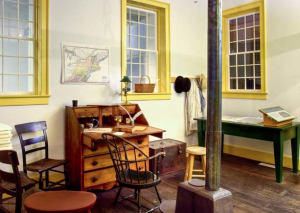 1829 Scots Roman Type, prepared in Glasgow Scotland, and shipped to a foundry in Albany New York, then delivered to the E. B. Grandin Printing company in Palmyra New York, according to the Crandall Gutenberg Printing Museum in Provo Utah. The Scots Roman type is the font used to print the first edition of the Book of Mormon. The contract with E. B. Grandin’s print shop to print the book was signed on Tuesday 25 Aug 1829, and the completed book was on sale by Friday 26 March 1830. Typesetter John H. Gilbert selects type and inserts commas, periods, and other punctuation as Gilbert reads Oliver Cowdery’s hand written copy. One form signarture of 16 pages, in quantities of 5,000 copies will be printed per 6 day 11 hour per day week. Meridian Magazine (14 Apr 2005). http://www.johnpratt.com/items/docs/lds/meridian/2005/printing.html
1829 Scots Roman Type, prepared in Glasgow Scotland, and shipped to a foundry in Albany New York, then delivered to the E. B. Grandin Printing company in Palmyra New York, according to the Crandall Gutenberg Printing Museum in Provo Utah. The Scots Roman type is the font used to print the first edition of the Book of Mormon. The contract with E. B. Grandin’s print shop to print the book was signed on Tuesday 25 Aug 1829, and the completed book was on sale by Friday 26 March 1830. Typesetter John H. Gilbert selects type and inserts commas, periods, and other punctuation as Gilbert reads Oliver Cowdery’s hand written copy. One form signarture of 16 pages, in quantities of 5,000 copies will be printed per 6 day 11 hour per day week. Meridian Magazine (14 Apr 2005). http://www.johnpratt.com/items/docs/lds/meridian/2005/printing.html
3rd form of 16 pages printed. Somewhere stlll in 1st Nephi.
https://www.lds.org/locations/book-of-mormon-publication-site-grandin-building#d
1847– Mexican-American War: Battle of Chapultepec. American General Winfield Scott captures Mexico City in the Mexican-American War.
1862 – American Civil War: Union soldiers find a copy of Robert E. Lee’s battle plans in a field outside Frederick, Maryland. It is the prelude to the Battle of Antietam.
1863 – Arthur Henderson, born at 10 Paterson Street, Anderston, Glasgow, Scotland British politician and union leader in 1931, recipient of the Nobel Peace Prize for 1934 (d. 20 October 1935)
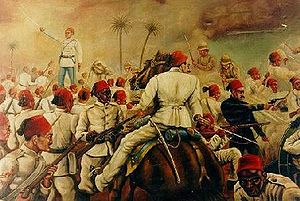 1882 – The Battle of Tel el-Kebir is fought in the 1882 Anglo-Egyptian War. Order of battle of the British Expeditionary Force 2nd Battalion, Coldstream Guards, 1st Battalion, Scots Guards, 2nd Battalion, Highland Light Infantry, 1st Battalion, Black Watch (Royal Highlanders), 1st Battalion, Cameron Highlanders, 1st Battalion, Gordon Highlanders , Indian Contingent (Maj Gen Sir Herbert Macpherson VC), 5 Battery, Scottish Division, RGA, Second Anglo-Egyptian War. In 1877, Her Majesty Queen Victoria, changed the regiment’s name to the now more
1882 – The Battle of Tel el-Kebir is fought in the 1882 Anglo-Egyptian War. Order of battle of the British Expeditionary Force 2nd Battalion, Coldstream Guards, 1st Battalion, Scots Guards, 2nd Battalion, Highland Light Infantry, 1st Battalion, Black Watch (Royal Highlanders), 1st Battalion, Cameron Highlanders, 1st Battalion, Gordon Highlanders , Indian Contingent (Maj Gen Sir Herbert Macpherson VC), 5 Battery, Scottish Division, RGA, Second Anglo-Egyptian War. In 1877, Her Majesty Queen Victoria, changed the regiment’s name to the now more 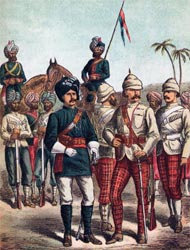 familiar Scots Guards.
familiar Scots Guards.
Soldiers of the Indian Army in Egypt (the Seaforth Highlanders still wear the trews of the old 72nd Regiment)
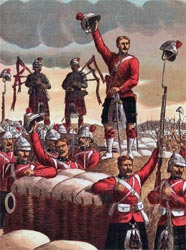 Black Watch after the capture of the Egyptian entrenchment at the Battle of Tel El Kebir. The Highland regiments fought in kilts, other than 1st Battalion, the Highland Infantry, which still wore the trews of the old 74th Regiment.
Black Watch after the capture of the Egyptian entrenchment at the Battle of Tel El Kebir. The Highland regiments fought in kilts, other than 1st Battalion, the Highland Infantry, which still wore the trews of the old 74th Regiment.
Highlanders storming the Egyptian entrenchment at the Battle of Tel-El-Kebi. The Seaforth Highlanders attacked the Egyptian redoubt.
Black Watch storming the Egyptian lines at the Battle of Tel El Kebir. Picture by Alphonse De NeuvilleDawn broke with the Highland Brigade within 150 yards of the Egyptian line. 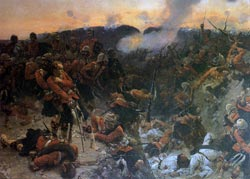 A heavy fire immediately broke out. The 4 regiments of the Highland Brigade, led by its commander, Major General Allison, and General Hamley, the Divisional Commander, stormed into the entrenchments, the two centre regiments, the Gordons and Camerons leading. The Black Watch on the right of the brigade found the resistance hard to overcome.
A heavy fire immediately broke out. The 4 regiments of the Highland Brigade, led by its commander, Major General Allison, and General Hamley, the Divisional Commander, stormed into the entrenchments, the two centre regiments, the Gordons and Camerons leading. The Black Watch on the right of the brigade found the resistance hard to overcome.
Disclaimer: The author of each article published on this web site owns his or her own words. The opinions, beliefs and viewpoints expressed by the various authors and forum participants on this site do not necessarily reflect the opinions, beliefs and viewpoints of Utah Standard News or official policies of the USN and may actually reflect positions that USN actively opposes. No claim in public domain or fair use. © John Choate.
Utah Standard News depends on the support of readers like you.
Good Journalism requires time, expertise, passion and money. We know you appreciate the coverage here. Please help us to continue as an alternative news website by becoming a subscriber or making a donation. To learn more about our subscription options or make a donation, click here.
To Advertise on UtahStandardNews.com, please contact us at: ed@utahstandardnews.com.


Comments - No Responses to “September 13th Scots Book of Days”
Sure is empty down here...